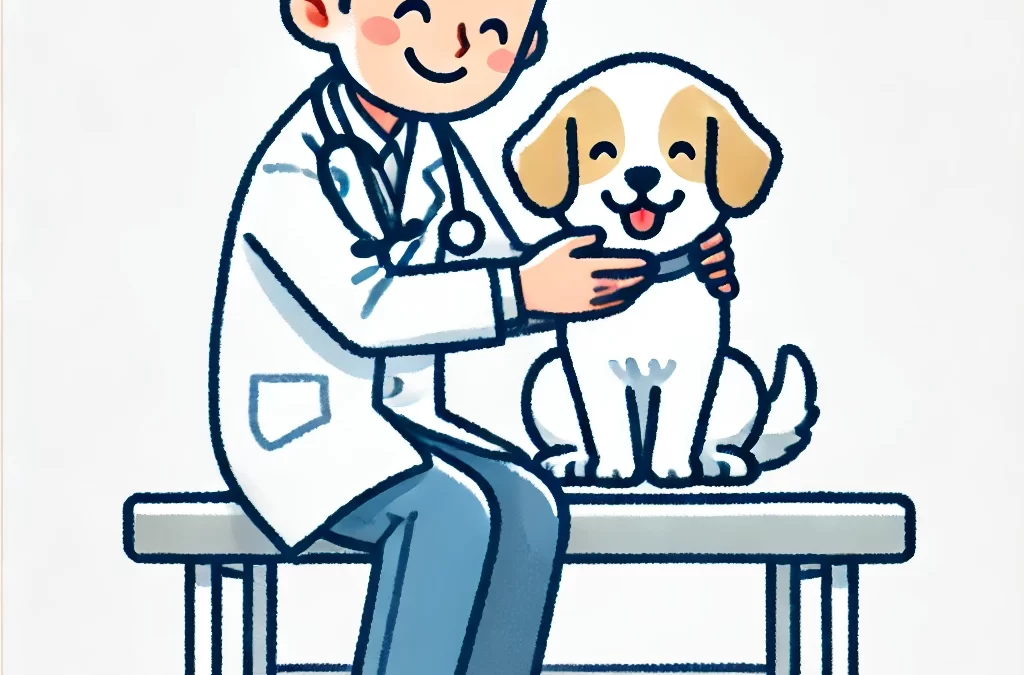
by TCMVET | Nov 30, 2024 | Dog Cancer & Tumors
When a beloved dog is diagnosed with cancer, it feels like the ground has shifted beneath you. But amidst the despair, there’s also a growing movement of pet owners, holistic practitioners, and researchers who believe that cancer in dogs doesn’t have to be an immediate death sentence. With the right combination of therapies, diet, and lifestyle changes, the progression of cancer can be slowed down, giving your dog more time to enjoy life with you by their side.
Here’s a fresh perspective on how to support your dog’s health and potentially slow the growth of cancer cells.
1. Think Beyond Traditional Medicine
While chemotherapy and surgery are standard treatments for cancer in dogs, many pet owners are now looking for complementary therapies that focus on boosting their dog’s immune system and overall well-being. Integrative medicine, which combines conventional treatments with natural and alternative therapies, has gained traction in recent years.
Therapies such as acupuncture, massage, and herbal treatments can help reduce inflammation, alleviate pain, and enhance your dog’s overall quality of life. You might also want to explore the world of cannabinoids, like CBD, which has shown promise in some studies for managing pain and reducing tumor growth. Always consult your vet before starting any alternative therapy, but it’s encouraging to see more options emerge.
2. Harness the Power of Nutrition
There’s a lot of buzz around the idea that what you feed your dog can influence their health—and that includes their ability to fight cancer. A cancer-supportive diet for your dog goes beyond just feeding them healthy food; it’s about creating an environment in the body that makes it harder for cancer cells to thrive.
Some nutritionists recommend ketogenic diets for dogs with cancer, which are high in fat, moderate in protein, and low in carbohydrates. This type of diet may deprive the cancer cells of the sugar they need to grow, slowing their progression. Adding anti-cancer superfoods like turmeric, mushrooms (shiitake, maitake, and reishi), and green tea extract can also provide a boost.
Lignans, compounds found in flaxseeds and other plants, have been linked to slowing the growth of cancer cells in dogs, particularly in cases of canine lymphoma. You might also want to talk to your vet about supplements like omega-3 fatty acids, antioxidants, and vitamin D, all of which play a role in maintaining immune function and supporting healthy cell regeneration.
3. Exercise and Mental Stimulation: A Balance of Movement and Rest
It’s easy to assume that your dog, once diagnosed with cancer, should rest as much as possible. But just like in humans, maintaining a balance of rest and activity can help keep your dog’s body functioning optimally. Regular, low-impact exercise can help improve circulation, reduce pain, and support your dog’s immune system.
Mental stimulation is just as important. Engaging your dog’s mind with interactive toys, training sessions, or scent games can boost their mental health and improve their overall outlook on life. A happier, less stressed dog is likely to be in better shape to cope with the challenges cancer brings.
4. A Holistic Approach: The Mind-Body Connection
One aspect of cancer treatment that’s often overlooked in both humans and pets is the mind-body connection. Stress and anxiety can weaken the immune system and create an environment in which cancer cells can thrive. Therefore, fostering a calm, stress-free environment is essential for your dog’s well-being.
Consider meditative practices or creating a sanctuary at home where your dog can feel safe and relaxed. This can include playing soothing music, creating a cozy bed in a quiet part of your home, or even aromatherapy with pet-safe essential oils. It’s a small, but powerful, step in ensuring that your dog’s body is in the best possible state to fight the disease.
5. Cutting-Edge Research and Experimental Therapies
We are living in an exciting time when medical research into cancer therapies is rapidly advancing. While the landscape for dog cancer treatment is still evolving, there are some fascinating new treatments that show promise, like immunotherapy and gene therapy. These cutting-edge therapies aim to trigger the dog’s own immune system to fight the cancer more effectively, often targeting tumors with greater precision than traditional methods.
Stay informed and advocate for your dog by consulting with specialists who are up-to-date on the latest treatments and clinical trials. You may be able to give your dog access to therapies that aren’t widely available yet, all in an effort to slow the progression of cancer and improve their quality of life.
6. The Power of Love and Compassion
Perhaps the most profound and often underappreciated aspect of managing cancer in a dog is the healing power of love and emotional connection. Your presence, attention, and care can be a huge comfort to your dog, reducing anxiety and stress, which can help their immune system function more effectively.
It’s not just about the food, the medicine, or the treatments—it’s about the bond you share. This relationship provides your dog with the strength to fight, the joy to live, and the comfort of knowing they are deeply loved, no matter what.
Conclusion: Slowing Cancer, One Step at a Time
Cancer in dogs is undoubtedly devastating, but it’s important to remember that there are many avenues for slowing its progression and supporting your dog’s health. By combining modern veterinary treatments with alternative therapies, proper nutrition, exercise, and emotional care, you can make a significant difference in your dog’s quality of life.
The road may be long, but with a holistic approach and a deep commitment to your dog’s well-being, you can help them live a fuller, happier life—one where cancer doesn’t define their story, but rather, the love and care you provide every day.

by TCMVET | Nov 29, 2024 | pet Chinese herbal medicine
When it comes to natural remedies for dogs, Lysimachia 3 is a rising star in holistic veterinary care. Rooted in the time-tested traditions of Traditional Chinese Medicine (TCM), this herbal formula is gaining attention for its potential benefits in supporting canine health, particularly for managing bladder stones, urinary tract issues, and inflammation. This article takes a unique perspective on why Lysimachia 3 might be the unsung hero of your dog’s health journey.
What Is Lysimachia 3?
Lysimachia 3, also known as “Three-Yellow Powder” in TCM, is a blend of three potent herbs:
- Lysimachia (Jin Qian Cao): Known for its detoxifying and stone-dissolving properties.
- Dandelion (Pu Gong Ying): A natural anti-inflammatory and diuretic.
- Plantain (Che Qian Cao): Supports urinary tract health and soothes irritation.
This trifecta of herbs works synergistically to address bladder health, reduce inflammation, and promote overall well-being.
Why Consider Lysimachia 3 for Dogs?
Unlike pharmaceuticals, which often focus on symptom management, Lysimachia 3 is designed to address the root cause of health issues. This approach aligns with a growing trend among pet owners seeking natural, gentle, and effective solutions.
Unique Applications of Lysimachia 3
1. Bladder Stones and Crystals
Lysimachia 3 is celebrated for its ability to help dissolve bladder stones and prevent the formation of urinary crystals. Its stone-breaking properties make it an excellent alternative for dogs that experience recurring urinary issues.
2. Urinary Tract Infections
Thanks to its antibacterial and anti-inflammatory effects, Lysimachia 3 can help alleviate symptoms of urinary tract infections (UTIs). It soothes the urinary tract, promoting healing and reducing discomfort.
3. Detoxification
Lysimachia 3 supports the liver and kidneys in flushing out toxins. This makes it a valuable addition to detox protocols, especially for dogs exposed to environmental toxins or long-term medications.
How to Use Lysimachia 3 Safely for Dogs
- Consult a Veterinarian: Always consult a veterinarian familiar with herbal medicine before introducing Lysimachia 3. Dosages vary based on your dog’s size, health condition, and specific needs.
- Powder or Capsule Form: The herbs can be administered as a powder mixed with food or in capsule form for convenience.
- Monitor for Reactions: While side effects are rare, keep an eye on your dog for any signs of digestive upset or allergic reactions.
The Modern Renaissance of Ancient Remedies
In an age dominated by synthetic drugs, the resurgence of herbal formulas like Lysimachia 3 is a testament to their enduring value. Modern research is beginning to validate what ancient practitioners have known for centuries: nature holds powerful solutions for health.
For example:
- Anecdotal Success Stories: Dog owners report significant improvements in their pets’ symptoms, from reduced urinary pain to complete resolution of bladder stones.
- Synergy with Conventional Medicine: Lysimachia 3 can complement traditional treatments, enhancing their efficacy and reducing dependency on antibiotics.
When to Consider Lysimachia 3 for Your Dog
Lysimachia 3 is not just for dogs with active bladder or urinary issues. It can also be used as a preventative measure for breeds prone to such conditions, like Dalmatians or Bulldogs. Additionally, it’s an excellent option for dogs recovering from bladder surgery or chronic UTIs.
Is Lysimachia 3 Right for Your Dog?
Lysimachia 3 stands out as a natural, holistic option for managing bladder and urinary health in dogs. Its unique blend of herbs addresses not only symptoms but also underlying causes, offering a comprehensive solution that aligns with modern pet owners’ preference for natural care.
Whether you’re exploring alternatives to surgery, managing chronic issues, or simply looking to enhance your dog’s health, Lysimachia 3 could be the herbal ally your furry companion needs. With its rich history and proven efficacy, this ancient remedy is stepping into the spotlight as a modern solution for canine wellness.

by TCMVET | Nov 29, 2024 | Dog Cancer & Tumors
When faced with the emotional and financial burden of a dog’s tumor diagnosis, many pet owners feel overwhelmed by the costs associated with treatment. However, low-cost dog tumor removal is not only possible but also accessible with the right resources and a bit of creativity. This guide explores unique and practical ways to ensure your furry friend gets the care they need without straining your wallet.
Understanding Tumor Types and Necessity for Removal
Not all tumors require immediate surgical intervention. Some, such as lipomas (benign fatty tumors), may pose little to no threat to your dog’s health. Consulting with your veterinarian to assess the nature of the tumor is the first step toward making an informed decision. If removal is deemed necessary, explore cost-effective options to address the issue.
Creative Approaches to Affordable Dog Tumor Removal
Vet Schools: Learning and Saving
Veterinary teaching hospitals often provide lower-cost services as students, under the guidance of experienced professionals, perform procedures. While costs are reduced, the quality of care remains high, making this an excellent option for budget-conscious pet owners.
Non-Profit Veterinary Clinics
Many non-profits and animal welfare organizations offer subsidized veterinary care, including tumor removal. Research organizations in your area that support low-income pet owners, such as the Humane Society or SPCA branches, which may provide financial aid.
Crowdfunding Platforms
Platforms like GoFundMe or Waggle allow pet owners to share their dog’s story and raise funds for medical procedures. A heartfelt narrative and photos can encourage donors to contribute to your pet’s well-being.
Payment Plans with Local Vets
Some veterinary clinics are open to setting up payment plans for costly surgeries. This option lets you spread the cost over several months, easing the immediate financial burden.
DIY Recovery and Aftercare
While the surgery itself should always be performed by a licensed veterinarian, you can save money by managing post-operative care at home. Learn how to clean wounds, administer medications, and create a comfortable recovery space for your dog to minimize additional clinic visits.
Exploring Alternatives: When Surgery Isn’t an Option
If surgery is beyond your financial means or not recommended due to your dog’s health, alternative therapies can help manage the tumor. Some holistic options include:
- Herbal Supplements: Natural remedies like turmeric, frankincense, and TCM formulas such as Chuanxiong have been noted for their anti-inflammatory properties.
- CBD Oil: Full-spectrum CBD oil may help reduce inflammation and support overall well-being.
- Dietary Adjustments: Anti-cancer diets focusing on whole, low-carb, high-protein foods may slow tumor growth.
Preventative Measures to Avoid Future Costs
Preventative care can reduce the likelihood of tumors forming in the first place. Regular vet check-ups, a balanced diet, and avoiding exposure to carcinogens like tobacco smoke can promote a healthier life for your dog. Early detection is key; small tumors are generally easier and less expensive to treat than advanced ones.
Compassion and Ingenuity: The Keys to Affordable Care
Finding low-cost options for dog tumor removal requires resourcefulness and determination. By leveraging non-profits, community support, and alternative therapies, you can ensure your dog gets the care they need without financial hardship. Remember, your creativity and love for your pet can pave the way for compassionate and effective solutions.
Whether it’s through connecting with a network of affordable care providers or embracing holistic approaches, your dog’s health doesn’t have to come at an insurmountable cost. Let this journey remind us of the unwavering bond between pets and their owners—a relationship worth every effort.

by TCMVET | Nov 28, 2024 | Dog Cancer & Tumors
When your dog starts limping or licking its paws excessively, the culprit might be an interdigital cyst—a condition both common and concerning. While these cysts are typically benign, their appearance can sometimes lead pet owners to question: could this be a sign of something more sinister, like cancer? Let’s delve into this topic with fresh eyes, exploring the distinctions, potential connections, and how to best approach these issues for your dog’s well-being.
What Are Interdigital Cysts?
Interdigital cysts, also known as furuncles, are fluid-filled lumps that form between a dog’s toes. They result from inflammation of the hair follicles in the interdigital spaces, often caused by:
- Trauma: Cuts or scrapes on the paws.
- Allergies: Environmental or food allergies leading to excessive licking.
- Genetic Predispositions: Certain breeds, such as Bulldogs and Labrador Retrievers, are more prone.
- Foreign Bodies: Splinters or debris embedding into the skin.
While interdigital cysts are usually non-cancerous, their recurring nature can cause discomfort, infection, and even lameness.
Can Interdigital Cysts Be Linked to Cancer?
The short answer: rarely, but not entirely impossible.
Most interdigital cysts are benign and not related to cancer. However, chronic inflammation caused by persistent cysts can potentially create an environment conducive to more severe conditions over time. This phenomenon, known as chronic inflammation-driven carcinogenesis, highlights how prolonged irritation may increase the risk of malignant changes in tissues.
Moreover, in very rare cases, lumps initially identified as cysts might actually be something more serious, such as:
- Squamous Cell Carcinoma (SCC): A type of skin cancer that can develop in the paw pads or between toes.
- Mast Cell Tumors (MCTs): These tumors, though commonly found elsewhere, can occasionally appear in unusual locations like the paws.
- Melanoma: Malignant melanomas may also manifest near the paw pads and resemble cyst-like growths.
How to Differentiate Between Cysts and Cancer
A proper diagnosis is crucial. Here’s what to watch for:
- Shape and Texture: Cysts are usually soft, round, and filled with fluid. Tumors may feel hard and irregular.
- Growth Rate: Benign cysts grow slowly, while malignant tumors often grow rapidly.
- Color and Ulceration: Cancerous growths might be discolored, ulcerated, or bleed spontaneously.
- Response to Treatment: Cysts often respond to antibiotics, anti-inflammatory medications, or drainage, whereas cancerous growths do not.
Veterinarians may recommend diagnostic tests like fine-needle aspiration (FNA) or biopsy to confirm whether a growth is benign or malignant.
Holistic and Preventative Care for Paw Health
Even if a cyst is non-cancerous, prevention and holistic care can improve your dog’s quality of life:
- Paw Hygiene: Regular cleaning reduces the risk of foreign objects embedding in your dog’s paws.
- Dietary Adjustments: Omega-3 fatty acids and anti-inflammatory supplements can reduce inflammation and promote skin health.
- Natural Remedies: Products like TCMVET Baituxiao or turmeric-based creams may help reduce inflammation in recurrent cysts.
- Moderated Exercise: For active dogs prone to trauma, consider softer terrains for walks to avoid cuts and abrasions.
When Surgery or Advanced Treatment is Needed
For persistent or complicated cysts, surgery might be required to remove the affected tissue. In rare cases of suspected malignancy, amputation of the affected toe may be necessary to prevent the spread of cancer. Advanced therapies like laser surgery or cryotherapy can also provide non-invasive solutions for certain cases.
The Takeaway: Knowledge is Power
Interdigital cysts, while common and mostly benign, should never be ignored. Staying vigilant, consulting your veterinarian, and adopting a proactive approach can make all the difference in ensuring your dog’s paw health. And remember, even if the specter of cancer arises, early detection and modern treatments offer promising outcomes.
Our furry friends rely on us for care and protection. By understanding the nuances of conditions like interdigital cysts, we can give them the best chance at a long, healthy, and happy life.

by TCMVET | Nov 28, 2024 | Dog Cancer & Tumors
When a beloved pet is diagnosed with a tumor, the emotional weight can feel overwhelming. Surgery often becomes the focal point of hope, but is it always the best option? Let’s explore the transformative journey of pet tumor surgery, the alternatives reshaping the landscape, and how holistic care is redefining healing for our furry companions.
A Historical Perspective: Surgery as a Lifesaver
In the early days of veterinary medicine, surgery was the definitive response to tumors. With advancements in technology, techniques such as laser surgery and robotic assistance have become common, making procedures safer and more precise. For example, oncological surgeries for pets today can achieve margins as small as a millimeter, preserving healthy tissue while removing the tumor.
However, the surgical path isn’t without its risks. Factors like the pet’s age, the size and location of the tumor, and underlying health conditions all influence the success rate. Despite its effectiveness in removing tumors, surgery often addresses only the symptom—not the root cause.
The Alternatives: A Growing Spectrum of Options
While surgery remains a cornerstone, alternative approaches are gaining traction:
- Cryosurgery: Using extreme cold to freeze and destroy tumor cells, this method is less invasive and ideal for superficial growths.
- Targeted Therapies: Innovations in veterinary medicine, such as immunotherapy and molecularly targeted drugs, are allowing for non-surgical tumor management. These treatments aim to shrink tumors or slow their progression.
- Natural Therapies: Herbal remedies like TCMVET Baituxiao and hemp-based supplements are becoming popular for their ability to support the immune system and inhibit tumor growth with minimal side effects.
- Palliative Care: For pets with inoperable tumors, comfort becomes the priority. Pain management, dietary adjustments, and physiotherapy play crucial roles in maintaining quality of life.
Weighing the Decision: To Cut or Not to Cut?
Choosing surgery or an alternative depends on multiple factors:
- Tumor Type: Benign tumors may not necessitate immediate surgery, while malignant growths often require prompt action.
- Quality of Life: Is the procedure likely to improve the pet’s well-being, or could it introduce undue stress and pain?
- Owner’s Goals: Some owners prioritize longevity, while others focus on comfort and holistic care.
Consultation with a veterinary oncologist is vital to ensure a tailored treatment plan that considers the pet’s unique needs.
Holistic Healing: Beyond the Scalpel
Post-surgical care is just as important as the procedure itself. Increasingly, holistic methods are being integrated into recovery plans:
- Nutritional Therapy: Diets rich in antioxidants, omega-3 fatty acids, and cancer-fighting compounds are pivotal.
- Acupuncture and Massage: These therapies can alleviate pain, boost circulation, and accelerate healing.
- Emotional Support: Pets, much like humans, benefit from a stress-free environment during recovery. Spending quality time, engaging in gentle play, and maintaining routines can uplift their spirits.
The Future of Pet Tumor Surgery
The field of veterinary oncology is evolving rapidly. Innovations such as AI-guided diagnostics and 3D-printed surgical tools promise even more precise and effective interventions. Additionally, research into the genetic basis of tumors in pets is paving the way for preventative strategies.
As these advancements unfold, the narrative around pet tumor surgery is shifting—from fear to hope, from reactive to proactive care.
A Final Thought
Whether opting for surgery or exploring alternatives, the ultimate goal is always the same: giving our pets the best life possible. With compassion, informed decision-making, and access to cutting-edge care, we can navigate this challenging chapter and emerge stronger—together.
When faced with a tumor diagnosis, remember: You are your pet’s advocate and biggest champion. Every decision you make comes from love, and that makes all the difference.





